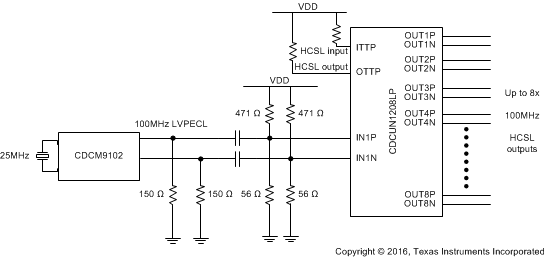SCAS922A February 2012 – April 2016 CDCM9102
PRODUCTION DATA.
- 1 Features
- 2 Applications
- 3 Description
- 4 Revision History
- 5 Device Comparison Table
- 6 Pin Configuration and Functions
- 7 Specifications
- 8 Parameter Measurement Information
- 9 Detailed Description
- 10Application and Implementation
- 11Power Supply Recommendations
- 12Layout
- 13Device and Documentation Support
- 14Mechanical, Packaging, and Orderable Information
Package Options
Mechanical Data (Package|Pins)
- RHB|32
Thermal pad, mechanical data (Package|Pins)
- RHB|32
Orderable Information
1 Features
- Integrated Low-Noise Clock Generator Including PLL, VCO, and Loop Filter
- Two Low-Noise 100-MHz Clocks (LVPECL, LVDS, or pair of LVCMOS)
- Support for HCSL Signaling Levels
(AC-Coupled) - Typical Period Jitter: 21 ps pk-pk
- Typical Random Jitter: 510 fs RMS
- Output Type Set by Pins
- Support for HCSL Signaling Levels
- Bonus Single-Ended 25-MHz Output
- Integrated Crystal Oscillator Input Accepts
25-MHz Crystal - Output Enable Pin Shuts Off Device and Outputs
- 5-mm × 5-mm 32-Pin VQFN Package
- ESD Protection Exceeds 2000 V HBM, 500 V CDM
- Industrial Temperature Range (–40°C to 85°C)
- 3.3-V Power Supply
2 Applications
- Reference Clock Generation for PCI Express
Gen 1, Gen 2, and Gen 3 - General-Purpose Clocking
3 Description
The CDCM9102 is a low-jitter clock generator designed to provide reference clocks for communications standards such as PCI Express™. The device supports up to PCIE gen3 and is easy to configure and use. The CDCM9102 provides two 100-MHz differential clock ports. The output types supported for these ports include LVPECL, LVDS, or a pair of LVCMOS buffers. HCSL signaling is supported using an AC-coupled network. The user configures the output buffer type desired by strapping device pins. Additionally, a single-ended 25-MHz clock output port is provided. Uses for this port include general-purpose clocking, clocking Ethernet PHYs, or providing a reference clock for additional clock generators. All clocks generated are derived from a single external 25-MHz crystal.
Device Information(1)
| PART NUMBER | PACKAGE | BODY SIZE (NOM) |
|---|---|---|
| CDCM9102 | VQFN (32) | 5.00 mm × 5.00 mm |
- For all available packages, see the orderable addendum at the end of the data sheet.
Simplified Schematic
